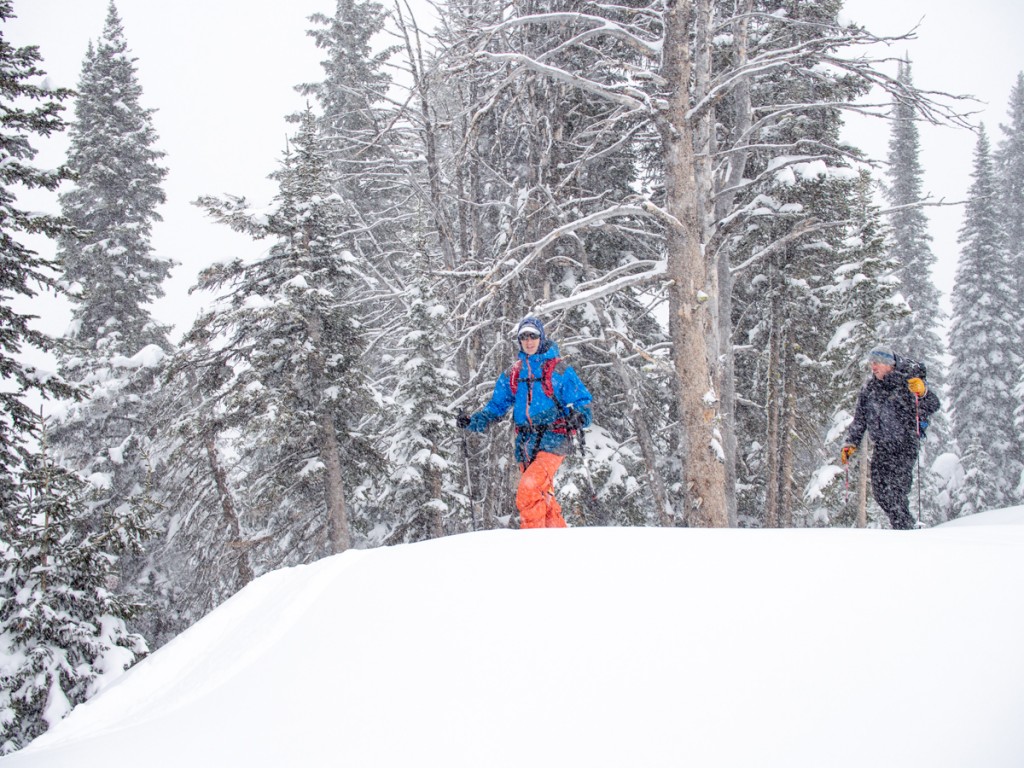The majority of our climbing skin testing is done while actually backcountry skiing. It's punishing, but we have a crack team that has the dedication and makes the sacrifices. We climb up mountains and ski back down them, but it isn't as complicated as it sounds. There is nothing like days and days and tens of thousands of feet of human-powered skiing, in all conditions, to draw out important observations.
Glide
When we say "glide," we specifically mean the amount of friction that resists sliding a skinned ski forward. This enhances your skinning efficiency. It is easy to see the benefits on the flats and downhills. When they slide, you proceed with less effort. It is less intuitive, but even more important, how low glide improves your uphill efficiency. For some reason, the biomechanics of which we don't fully understand, it is easier to slide your skis forward than to lift them forward. When your skins slide with less resistance, you spend less energy. We test for this by skinning and sliding around. We test each pair head to head with others to get relative performance attributes. Comparative glide characteristics vary with snow conditions. Some skins will be faster on dry, mid-winter snow, while others might be faster on snow that has undergone melt-freeze metamorphosis. We aim to test all skins in both of these conditions.
Portability
Portability should be as simple as weight and packed dimensions. We note those things, to be sure. However, since we test skins on tester skis (each of which can have varying dimensions, requiring skins of different dimensions), we can't make ready, direct size and weight comparisons. Further, portability is a function not just of weight and bulk. One must also consider rigidity of the packed bundle. The end result is that our portability scores are adjusted for all these variables. When we can, we compare skins trimmed for the same or similarly dimensioned skins.
Glue Integrity
The glue metric includes everything about the glue and the skin's stickiness. We ask skin glue to stick tenaciously to our skis, to stick to itself, and to pull easily from these surfaces. We also expect the glue to permanently remain where it belongs. The glue itself has a lot to do with this overall integrity, but it isn't the only thing. In terms of sticking to your skis, stiffer material is typically more resistant to rolling and subsequent glue failure. Competing demands mean that the best products are solidly in the middle. To deduce glue performance requires many rounds of usage and extensive comparison over time.
Grip
To assess traction or grip, we skin up steep hills on a variety of snow surfaces. Head-to-head comparisons, with different skins on each foot, are especially helpful here.
Icing Resistance
Icing occurs when skin material is exposed to liquid water in the snow, and then that wetted skin material comes into contact with colder, dry snow. The cold, dry snow amalgamates with the liquid water and creates ice in and on the skin grip side. The only real treatment is to prevent initial wetting. Skin manufacturers accomplish this with materials (nylon is more resistant to water than mohair) and hydrophobic treatments. The material remains intact for the life of the skins, but any initial treatment will wear off within a few big touring days. We've found that icing resistance, aside from any maintenance or technique considerations, is most dependent on skin material. Our field testing usually verifies this. When we encounter an exception to the rule, we note that too.
Compatibility
Compatibility is easily determined. Either skins are made to work with a specific model and size and tip/tail configuration, or they are "universal". Specific model skins are less compatible. Among universal skins, we look for a range of available sizes, tip and tail attachments that work with all different ski shapes, and the ease of trimming and set up.
Conclusion
There are a few things we can assess "objectively", but most of how we test backcountry ski climbing skins is in actual, on-the-go field use. We assemble a crack team to do so and cover literally thousands of miles and hundreds of thousands of vertical feet during testing. It doesn't take much to convince this team to put in the hard work.






